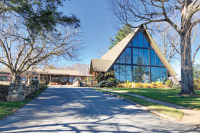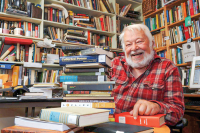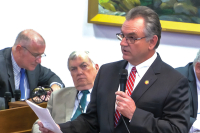New park visitor center to showcase stored artifacts
A design has been finalized for a new $3 million visitor center at the North Carolina entrance to the Great Smoky Mountains National Park outside Cherokee.
The new visitor center will focus on the cultural history of the park, from early Native Americans to Appalachian heritage. The park has thousands of artifacts collected from people who once lived in the park, but they are locked up in storage since the park has nowhere to display them. The new visitor center will finally put the public in touch with some of these implements of early life, from spinning wheels to farm tools to moonshine stills.
“We are going to be using those artifacts to tell the story of the people who lived here,” said Kent Cave, a park ranger who supervises visitor outreach with a specialty in Appalachian studies. “This is a fulfillment of a dream and of a promise.”
Cave said the original plan for the park dating back to the 1940s called for a cultural heritage museum on the N.C. side of the park, while the visitor center on the TN side focuses on ecology and natural history of the Smokies.
The cultural heritage theme will dovetail with the Mountain Farm Museum already in place at Occonaluftee, where visitors can see old farm buildings and demonstrations of early life.
“You aren’t just talking about the stuff, you are out there with it,” said Bob Miller, spokesperson for the park. “You can feed the chickens and talk to people about what they are seeing. This will be an extension of the farm.”
Miller said the park will judiciously select which artifacts go on display, since the park has far more than the new visitor center can possibly hold.
“A tiny portion of this stuff will be on display, just like at the Smithsonian where only a tiny portion of what they have is displayed for the public,” Miller said.
The current visitor center at Occonaluftee is old, cramped and doesn’t do justice to the most visited national park in the country.
Nearly 2 million people crossed into the park via the entrance on U.S. 441 last year, passing by the doorstep of the visitor center. Only 350,000 people ventured inside, but far more might stop in if it offered more in the way of exhibits.
The old visitors center was constructed in the 1930s by the Civilian Conservation Corp with the intention of serving merely as a ranger station. It is only 1,100 square feet, while the new one will be almost 7,000.
The old visitor will be converted to classroom space. The new visitor center will be constructed beside it. The parking lot will be reconfigured, along with the entrance off U.S. 441.
“We are extremely excited about having a new state-of-the-art facility,” said Park Superintendent Dale Ditmanson.
Ditmanson lauded the fundraising that will pay for the entire cost of the new center.
The Great Smoky Mountains Association, which operates bookstores in the park, has committed $2.5 million for its construction. The Friends of the Smokies will provide the $500,000 to design and create all the maps, exhibits and displays.
The visitor center will meet national certification standards as an environmentally friendly building under LEED (Leadership in Energy and Environmental Design).
“The new Center is being designed be as energy efficient and sustainable as we can make it,” Ditmanson said.
Some of the environmental designs being considered are
• Geothermal Heat and Cooling: The heating and cooling system will take advantage of the constant 55 degrees temperature of the earth, by pumping water into the ground though tubing where it will gain or give off heat, increasing the efficiency of the system.
• Passive solar: The orientation of the building and the select placement of windows will allow plenty of sunshine into the building and also provide heat. Working with the Oak Ridge National Laboratory, the Park has taken solar measurements where windows are to be placed, to be sure they are sized correctly, to allow just the right amount of light, and offset the need for heat.
• Rain water cistern: A cistern will be collect rain water from the roofs. The water will be filtered and then used to flush toilets.
• Water Saving Fixtures: Bathroom fixtures will use waterless urinals and water saving water faucets and toilets.
• Recycled Materials: Everything from roofing materials, to cabinets, siding, and structural supports will be made of recycled materials.
• Landscaping: Natives plantings will be used that will not require extensive watering after they become established.
Airport runway battle heats up in Macon: Cherokee fight to save artifacts from destruction
Emotions are sizzling over a plan to extend the Macon County Airport runway over Cherokee burial grounds and artifacts.
At an Airport Authority meeting last week in Franklin resident Selma Sparks said it is disrespectful to the Cherokee.
Airport board member Harold Corbin balked at that statement, saying the Cherokee didn’t make a big deal about artifacts when the casino was being built. Corbin added that there are artifacts all over Macon County and that just as many can be found on his farm as at the airport site.
Resident Alex Hawkins, who said he lives “at the end of the runway,” also disagreed with the project, saying it is unnecessary to extend the runway for economic development because there is no industry coming here.
An archaeological assessment commissioned by the Airport Authority in preparation for the runway expansion called the site one of the more significant archaeological areas in the state.
But Airport Authority Attorney Joe Collins said that is an opinion, and the airport board doesn’t think the site is as significant as the archaeologist said it was. There are an estimated 300 to 400 Cherokee burials at the site, according to the assessment.
At the request of the Eastern Band, none of the burials will be removed. Cherokee Chief Michell Hicks said someone’s final resting place should not be tampered with. The question is what to do with the other artifacts littering the site.
The Airport Authority has agreed to excavate 25 percent of the artifacts from the project site, but the tribe wants 100 percent of the artifacts removed. Otherwise those artifacts could be destroyed, and with them clues to early life.
Airport Authority Chairman Milles Gregory said 100 percent of the artifacts cannot be removed because it would cost too much.
The Airport Authority has contracted with TRC Environmental of Chapel Hill to recover the artifacts for $535,000.
The 4,400-foot runway will be extended by 600 feet. The Macon County Airport Authority claims the extension is necessary to make the runway safer.
Gregory said a husband and wife died in an airplane crash at the airport about 10 years ago because the runway wasn’t long enough for them to land safely.
“Which is more valuable, an artifact or a life?” Gregory asked.
Economic development is not the driving factor behind the runway extension, but is a side benefit, said Gregory.
Hicks questions whether the runway extension is actually needed.
“I believe the case has not been made that the airport expansion is necessary or even feasible,” the chief said in a statement.
Project engineer Eric Rysdon with WK Dickson of Charlotte said he hopes construction on the extended runway can begin this summer.
Fight could move to county commissioners
While the Macon County Airport Authority isn’t budging for now, county commissioners may have some say in how the project moves forward. The runway expansion will be funded partially with county tax dollars.
The entire project cost with archaeology included is expected to be around $3.3 million — with 90 percent of the funding coming from the N.C DOT Division of Aviation, and 10 percent from a county match.
Gregory said the county committed the match money years ago.
Commissioner Bob Simpson agreed the match money has already been committed but said those funds could possibly be taken away from the project.
Gregory said he doesn’t know how it would affect the project to lose the county’s match.
Simpson doesn’t necessarily advocate taking away the funds but said he would like to see a compromise worked out with Cherokee.
Two ideas Simpson has are to have Cherokee fund 100 percent of the artifact recovery. But Hicks said he opposes that idea, saying it is up to the county to cover the archaeology costs.
“It’s not EBCI’s responsibility,” said Hicks. “They need to do the right thing. Whether it’s the county or the Airport Authority.”
Another idea Simpson has is for Cherokee to make an economic investment in Macon County by marking the significant archaeological sites and making them a tourist attraction. In exchange, the county would not proceed with the runway extension.
Simpson said it is important that something is decided quickly because the Airport Authority is in danger of losing the grants if it doesn’t use them soon.
Commission Chairman Ronnie Beale and Commissioner Brian McClellan said they could not comment on the project until they have all the facts.
The Airport Authority is presenting the project to county commissioners at the March 9 commission meeting.









